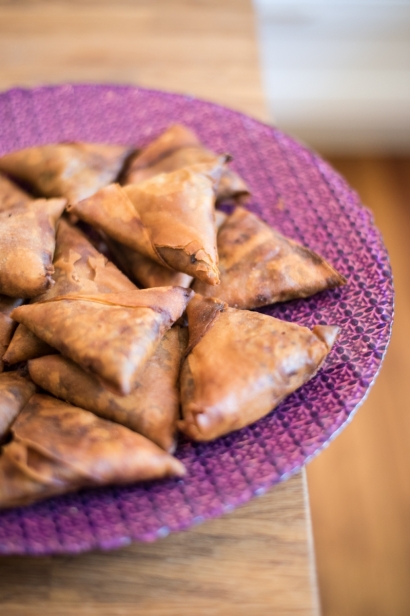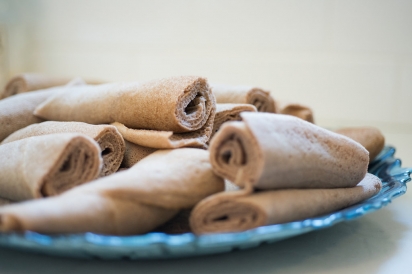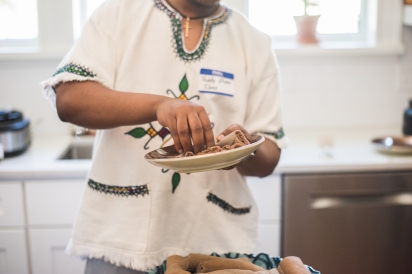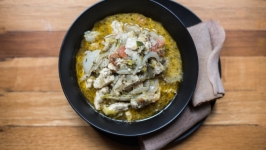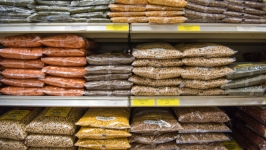Vicarious Kitchen: Ethiopia
Exploring international cuisine provides us with a palate-pleasing adventure, combining familiar ingredients with the unfamiliar flavors and spices typically found in another country. Enjoying ethnic cuisine while dining out is a first step. But learning to cook it oneself is a whole other matter. When we seek to understand how ingredients come together, and how methods affect flavor, we acquire a new understanding of food profiles and textures. We also gain a new vocabulary, stumbling over the names of dishes, native to another language.
The team at Vicarious events recently set forth to help bring global flavors to the home kitchens of our region with the launch of Vicarious Kitchen. Their first event focused on Ethiopian food and drink, with demonstrations by Teddy Aboye and Yordanos Woldetsadik of Ibex Ethiopian Kitchen. Over a half-dozen traditional Ethiopian dishes were served atop roll after roll of tangy injera, and the experience left us wanting even more! More information on Ethiopian cuisine, that is. (Okay, okay -- and more kitfo and tomato fit-fit too).
Shortly after our meal, we were inspired to compile a list of common Ethiopian ingredients and dishes, found here and abroad, as a guide to adventurous home cooking. Interested in hosting an Ethiopian dinner party? Here's an overview of things you should know:
Injera
What is the first dish that comes to mind when you think of Ethiopian food? Perhaps you have heard of injera, a sourdough flatbread used instead of utensils to pick up food during a meal. This is a key component of any Ethiopian meal, with a tangy flavor and spongy, crepe-like consistency. Injera is made out of fermented teff, a grain that grows in the highlands of Ethiopia and is rich in nutrients such as iron and calcium.
Berbere
A spicy ingredient added to most Ethiopian stews, berbere is made of ground semi-spicy chili peppers (also called berbere) mixed with more than 20 different herbs, spices and other ingredients including garlic, cumin, fenugreek, coriander and ginger.
Mitmita
Mitmita is another core spice blend composed of chili peppers (smaller and hotter than berbere), cardamom seed, cloves and salt. This is often used in meat dishes during the cooking process or as a condiment added while eating.
Niter Kibbeh
Similar to ghee used in Indian cooking, niter kibbeh is a spiced clarified butter, seasoned with garlic, onions, turmeric, ginger, black pepper and optional spices such as cardamom, cumin and fenugreek.
Tibs
The workshop included a cooking demonstration on how to prepare Tibs, a dish seasoned with a spice called corrorima. Tibs is a type of dish that includes stir-fried meat (in this case chicken), onions, other vegetables and sometimes rosemary. Because corrorima may be difficult to find in the U.S., Teddy recommended substituting a blend of Italian seasonings. Occasionally Tibs is made with more spice by adding berbere.
Wot
Considered to be a mainstay in Ethiopian cuisine, this dish is a spiced, slow-cooked stew that can be made with a variety of ingredients, including vegetables (Atkilt Wot), fish (Asa Wot), chicken (Doro Wot), lamb (Alicha Wot) or beef (Key Wot). Some variations of wot are seasoned with berbere or curry spices.
Sambusa
This triangular pastry is often served as an appetizer. It is either baked or fried and can be filled with potatoes, lentils, onions or minced meats.
Kitfo
Often served raw, as the last dish of the meal, this is made of minced beef seasoned with niter kibbeh and mitmita.
Tej
Ethiopian honey wine, brewed from raw honeycomb and hops.
Gomen or Ye'abesha gomen
Gomen is a simple, flavorful dish made from kale (or collard greens), onions, niter kibbeh, cardamom, fenugreek, nigella seeds and other spices sautéed and simmered together. This is commonly served on Fasting Plates in Ethiopia on Wednesday and Friday when practicing Orthodox Ethiopians (the majority of the population) forego meat and dairy products. These dishes are also common during the fasting periods before Ethiopian Orthodox Christmas and Easter.
Wondering where to shop for your first Ethiopian meal? There are a number of international markets in our region that offer imported products, spices, lentils, yellow split peas and hard-to-find ingredients. Ethiopian ingredients, in particular, can often be sourced at local Indian markets, such as Raja’s Indian Spices.



